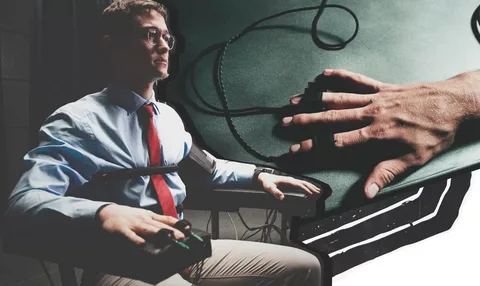The Evolution of Instrumental Lie Detection
The need to detect lies has existed since humans first began forming communities. Traditionally, this task was handled by the wisest members of the group—chiefs, elders, or judges. Throughout history, different cultures developed various special techniques and rituals to identify deception and expose liars. Even in ancient times, it was observed that people who committed crimes often experienced physiological changes due to fear of being caught.
Ancient Methods of Lie Detection
For example, in Ancient China, a suspect would undergo the “rice test”: they had to put a handful of dry rice in their mouth and listen to the accusation. If the rice remained dry (since fear could inhibit saliva production), the suspect was considered guilty. In Ancient India, suspects were presented with neutral and critical words related to the crime and had to respond with the first word that came to mind while quietly striking a gong. Stronger strikes typically accompanied responses to critical words.
In Africa, a shaman would ask suspects to hold a small bird’s egg with a fragile shell. The suspects would pass the egg to each other, and it was believed that the guilty party would crush the egg under pressure, thus revealing themselves.
The Beginnings of Instrumental Lie Detection
The history of instrumental lie detection began with the work of Italian physiologist Angelo Mosso. In 1877, using a plethysmograph (a device for measuring blood volume and pulse changes), Mosso discovered that presenting fear-inducing images to a subject affected their heart rate.
The first practical use of such instruments for lie detection is credited to the renowned Italian criminologist Cesare Lombroso. In 1881, during interrogations of crime suspects, Lombroso used a hydrosphygmograph—a device that recorded changes in blood pressure on a graph, allowing for detailed analysis. In his 1895 book “The Criminal Man,” Lombroso described a successful case where the hydrosphygmograph helped clear a suspect in a robbery case by showing no significant blood pressure changes in response to crime-related stimuli, but a drop in response to questions about a different case, which was later confirmed.
In 1902, Lombroso was involved in investigating a rape and murder case. He again used the hydrosphygmograph during the suspect’s interrogation. While analyzing the data, Lombroso noticed minor pulse changes when the suspect performed mental calculations, but no sudden changes when shown images of injured children, including the murdered girl. Later investigation proved the suspect’s innocence.
Working with Lombroso, Mosso also found that breathing patterns changed in response to different stimuli. In 1914, Vittorio Benussi, a professor at the University of Graz, published research showing that the frequency and depth of breathing cycles, as well as the ratio of inhalation to exhalation, changed when a person lied.
The Invention of the Polygraph
However, the invention of the polygraph is most often attributed to William Marston. After graduating from university, Marston attended Harvard for graduate studies, focusing on the relationship between human behavior and physiological processes. He developed a test to detect lies based on systolic blood pressure, which became the subject of his doctoral dissertation. Marston created both the test and the device, later known as the polygraph.
Marston’s wife, Elizabeth, contributed the idea that her blood pressure rose when she was angry or excited, which inspired his research. With funds from a loan, Marston set up a laboratory where he and his wife worked together (a family photo from 1920 documents this). The first polygraph resembled a cardiograph, as it recorded blood pressure. The polygraph later inspired the “Lasso of Truth” in Marston’s Wonder Woman comics and contributed to his feminist theories.
Further Developments and Modern Use
Another view is that the first prototype of the modern polygraph was built in 1921 by John Larson, a California police officer. Larson’s device simultaneously recorded changes in blood pressure, pulse, and respiration, and he used it regularly in criminal investigations.
In 1933, Leonard Keeler, a student of Larson and a staff member at the Northwestern University Scientific Crime Detection Laboratory, created a portable field polygraph that included a skin resistance measurement channel. Keeler later organized mass production of these polygraphs.
In Russia, instrumental lie detection using polygraphs was mainly developed in the 30th KGB laboratory, led at the time by Yuri Konstantinovich Azarov. By 1979, only about ten people in the USSR were professionally and officially engaged in lie detection. Due to a lack of fundamental knowledge, experience was gained through trial and error. Today, leading Russian polygraph examiners—Valery Vladimirovich Korovin, Alexander Petrovich Soshnikov, Leonid Georgievich Alekseev, and Viktor Nikolaevich Fedorenko—are all alumni of this laboratory. Each now heads their own school, tracing their roots back to the KGB era.



